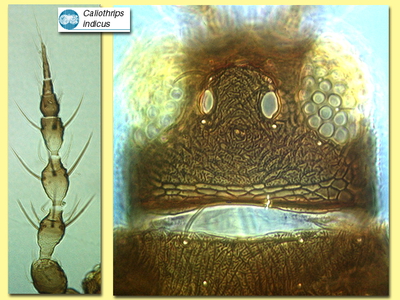Figures
Fig. 1 Antenna and head
Fig. 2 Fore and hind wing
Fig. 3 Tergite III and IV, sternites (male)
Species
Caliothrips indicus Bagnall
Biology
In India this species is a pest on soybeans, peas, clover and other legumes, sometimes causing considerable yield reduction through feeding damage to leaves.
Distribution
Widespread in India, and reported as a pest of groundnut in Thailand.
Recognition
Colour brown except - tarsi and apices of tibiae yellow, antennal segments III-V mainly yellow; forewings with 3 transverse pale bands - sub-basally, medially and sub-apically. Head not constricted into a basal neck, dorsal surface with complex sculpture medially comprising many fine lines within ill-defined reticles. Antennae with 8 segments, III & IV constricted into a neck at base and apex, each bearing a long forked sense cone; VIII as long as VI+VII. Pronotum with longitudinal reticulation and many fine lines within each reticle. Metathoracic endofurca elongate and lyre-shaped. Forewing first vein with about 5 setae basally and 2 setae near apex; second vein with about 7 setae. Tarsi all 1-segmented. Abdominal tergites III-V laterally with oblique elongate reticles with many internal lines of sculpture, VI-VI with these reticles almost transverse; VIII posterior margin with a craspedum medially but a few teeth laterally. Male smaller than female with slender abdomen, sternites III-VII with slender, curved transverse glandular area; tergite IX with one pair of moderately stout setae medially.
Related species
Closely similar to C. graminicola, a species widespread on grasses from Transvaal and Sudan to India and northern Australia. However, C. indicus has the tergal sculpture forming more clearly defined linear reticles, rather than lines of sculpture with few marking in between, and the males of C. graminicola have glandular areas only on sternites IV-VII and these are smaller.




